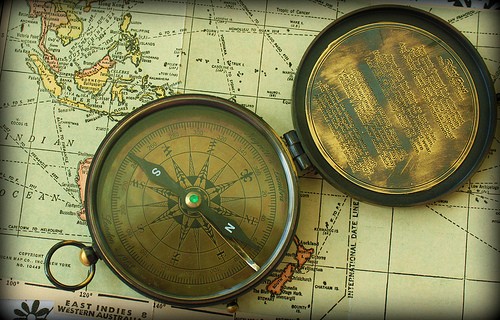Navigation can be overwhelming when your survival depend upon it. Here are some tips to navigate your way to your destination.
Orienting Your Map to True North
The first step of orienting with our map and compass is to make sure north on the map lines up with north in our terrain. Remember, maps are drafted with north at the top. If you’re facing south, but are holding the map right side up, everything on your map is going to be ass-backwards.
Luckily, orienting your map is easy.
Put your compass on your map. Look at which way the red needle is pointing.
Turn your map so that north on the map, points in the same direction as the needle.
Taking a Bearing From a Map
1) Place the compass on the map with one long edge of the baseplate running between the two points of interest. Make sure the direction of travel arrow is pointing to the spot that you’re trying to get to. (Note: Ignore the magnetic compass needle. We’re not using it at all during this entire process.)
2) Turn the bezel on your compass so that north on the compass points to north on the map. The housing lines should be parallel with the map’s vertical grid lines.
3) Read the number at the index line. That’s your bearing from point A to point B.
Transferring a Bearing Taken From Your Compass to Your Map
1) Take a bearing to a visible landmark using your compass.
2) Identify where you are on the map and place the compass edge over this location.
3) Using your location as a pivot, rotate the compass until north on the bezel is pointing to the top of the map and the compass housing orienting lines are parallel with the map’s vertical grid lines. The edge of the compass baseplate is now pointing in the direction of the visible landmark from which you took your bearing.
Figuring Out Your Location on a Map Using Point, Line, and Area Position
Let’s say you’re out hiking. You’ve got your trusty compass and a map of the area, but you don’t know exactly where you are in relation to the map. With a little bit of compass work, you can figure this out.
Point position. When you do know exactly where you are in relation to your map, you have your “point position.”
When we know our point position, we can identify any landmark that we see in our terrain by using the map. Let’s say you’ve hiked the peak of Camel’s Hump in Vermont. You look out into the distance and you see another mountain peak, but you don’t know the name of it. All you have to do is shoot a bearing towards the unidentified peak. You discover that it has a bearing of 176°. Take that bearing and plot it on the map using the technique explained above.
When we don’t have our point position, we have to use less exact forms of orientation based on line or area position to find it:
Line Position. When you have a line position, you know that you’re on some identifiable line on the map (trail, ridge line, etc.), you just don’t know exactly where. You don’t have your point position. Not a problem. You just need one more piece of information to figure out exactly where you are on the map.
For this example, we’re going to go to the Wichita Mountains Wildlife Refuge in Oklahoma. We know we’re somewhere along HW 115 and south of Saddle Mountain. We just don’t know where exactly. We can find out easily enough, though.
Shoot a bearing with your compass at the peak of Saddle Mountain. You see that the mountain is 24° in relation to you.
Go to your map. Orient your map so that it’s lined up with magnetic north (see above). On your map, shoot the back bearing that you just took with your compass from the top of Saddle Mountain. In this case, it would be 204° (24+180).
Using the side of your compass, draw a line towards the highway that you’re on. Where the line intersects with the highway is where you are on the map.
It might seem difficult at first, but with proper practice, you'll be able to find your way around in no time. That way if you were to get lost while bugging out, you knew you'd be able to get back to your bug out cabin or campsite. For more information and suggestions on how to navigate your way in the wild, check out the Art of Manliness.
Featured Image via Calsidyrose/Flickr

WARNING!! i WENT TO THIS SITE AND WHEN i CLICKED ON NEXT PAGE MY COMPUTER FROZE WITH A VIRUS POPUP!
I was a land nav SME.